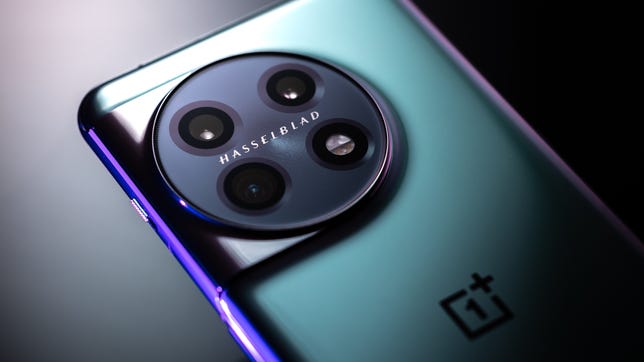The $699 OnePlus 11 is the company’s first true flagship to launch in 2023, and it offers plenty to get excited about. From its slick refreshed design to its hyper-powerful processor and fast charging skills, this phone works hard to earn its flagship title.
But it’s not a massive overhaul from last year’s already excellent OnePlus 10 Pro. It’s similar in design, it’s got a hefty (arguably redundant) boost in power and the new camera setup, while good, isn’t a big leap forward. If you were hoping to see a radical new OnePlus phone, you may be disappointed. Owners of recent OnePlus devices shouldn’t consider upgrading.
Price is certainly on its side. The OnePlus 11 base model is $699 ( 729 or roughly AU$1,270) comes with 8GB of RAM and 128GB of storage. Even the higher-end review model I tested, with 16GB of RAM and 256GB of storage, will only set you back $799 ( 799), undercutting its rivals by a decent chunk. The phone’s biggest competition comes from the superb Google Pixel 7 Pro, which at $899 isn’t a big step up in cost (it’s $999 for the equivalent 256GB model, although there’s no boost in power with the extra storage here).
Like
- Incredible performance for gaming
- Slick, refreshed design
- Hyper-fast charging
- Five years of security support
Don’t Like
- Cameras are good but not great
- Better waterproofing on rivals
The Pixel 7 Pro was one of our favorite phones of 2022, earning a coveted CNET Editors’ Choice award when it launched in October thanks to its superb cameras, slick interface and attractive design. It’s an amazing phone and one of my favorite ways to experience Android 13.
Where the OnePlus 11 excels is in its raw power, offering blistering speeds for gaming and heavy multitasking. It charges quicker than Google’s phones too. The Pixel’s Tensor G2 processor isn’t built for straight-line speed, but still handles anything you’ll find in the Play Store. The Pixel’s pure Android 13 software is clutter-free, and the cameras generally perform better — especially with the addition of the 5x optical zoom lens, which the OnePlus lacks.
Then there’s the new Samsung Galaxy S23, which starts at $800 and comes with a 6.1-inch display, a triple-camera setup, 8GB of RAM and the latest Qualcomm 8 Gen 2 processor. It’s the same chip you’ll find in the OnePlus 11, though it’s been customized for Samsung. With the S23 range going on sale on Feb. 17, we’ll have to wait to see how the new Samsung and OnePlus’ phones stack up against each other.
OnePlus 11: A refreshed design, now with added waterproofing
OnePlus’ flagship has arrived in 2023 with a fresh look, swapping out the square camera unit of the 10 Pro for a circular one, fringed with metal that curves gracefully to meet the edge of the phone. My review model’s green tone looks both stylish and smart, while the curving glass on both the front and back makes it satisfying to hold.
I love the phone’s look. It manages to appear different from its predecessors, while still looking familiar enough to feel part of the same family. The glass is toughened Gorilla Glass, so don’t worry too much about shattering it. The new phone one-ups the 10 Pro by coming with an IP64 rating for protection against water. The lack of waterproofing on most versions of the 10 Pro was annoying as it’s something we’ve come to expect on all flagships. So, it’s good to see more official protection here.
Read more: How Waterproof Is My Phone? IP Ratings Explained
That said, IP64 only offers mild protection against water splashes while rivals — including the Pixel 7 Pro, iPhone 14 range and Galaxy S23 range — all have IP68 ratings which protect them from actual submersion in water for at least 30 minutes. IP64 is better than nothing though and will certainly help keep your phone safe when you take calls in the rain.


The rounded camera unit is a nice touch.
Andrew Lanxon/CNETAt 6.7 inches, the display is sizable enough to do justice to mobile games, while its maximum 3,216×1,440-pixel resolution makes everything look nice and crisp (you can opt for a lower resolution to help eke out the battery life). It’s a SuperAMOLED panel that supports Dolby Vision HDR and HDR 10 Plus, meaning it’s bright, bold and capable of properly showing off compatible HDR content.
Its adaptive frame rate can shoot up to 120Hz to provide a smooth experience for high-intensity tasks like gaming, but can dynamically drop to only 1Hz to save power for less demanding tasks like web browsing or showing the always-on display.
There’s an in-display fingerprint scanner, which works well. Longtime OnePlus fans will be pleased to see the alert slider on the right of the phone, which lets you instantly set the phone to silent or vibrate. The slider was notably absent on last year’s OnePlus 10T.
OnePlus 11: Potent power
Powering the phone is the aforementioned Qualcomm Snapdragon 8 Gen 2 processor, backed up by a meaty 16GB of RAM (on my review model). It’s a potent chip that put in some seriously impressive scores on our suite of benchmark tests, landing it comfortably among the most powerful phones around.
Benchmarks don’t mean everything, of course, but rest assured that this phone will handle anything you care to throw at it. Its graphics performance is particularly strong. Demanding games like Genshin Impact, PUBG Mobile and Asphalt 9: Legends (all at max resolution) displayed at consistently high frame rates for smooth gameplay.
OnePlus touts the phone’s “optimized RAM allocation,” “hardware-accelerated ray tracing” in games and “best in class” lighting and illumination effects, which is all well and good, but there aren’t any games available on Android yet that support things like ray tracing. It’s like having a car capable of driving on MagLev tracks — amazing technology, sure, but no way of actually putting it to use just yet.
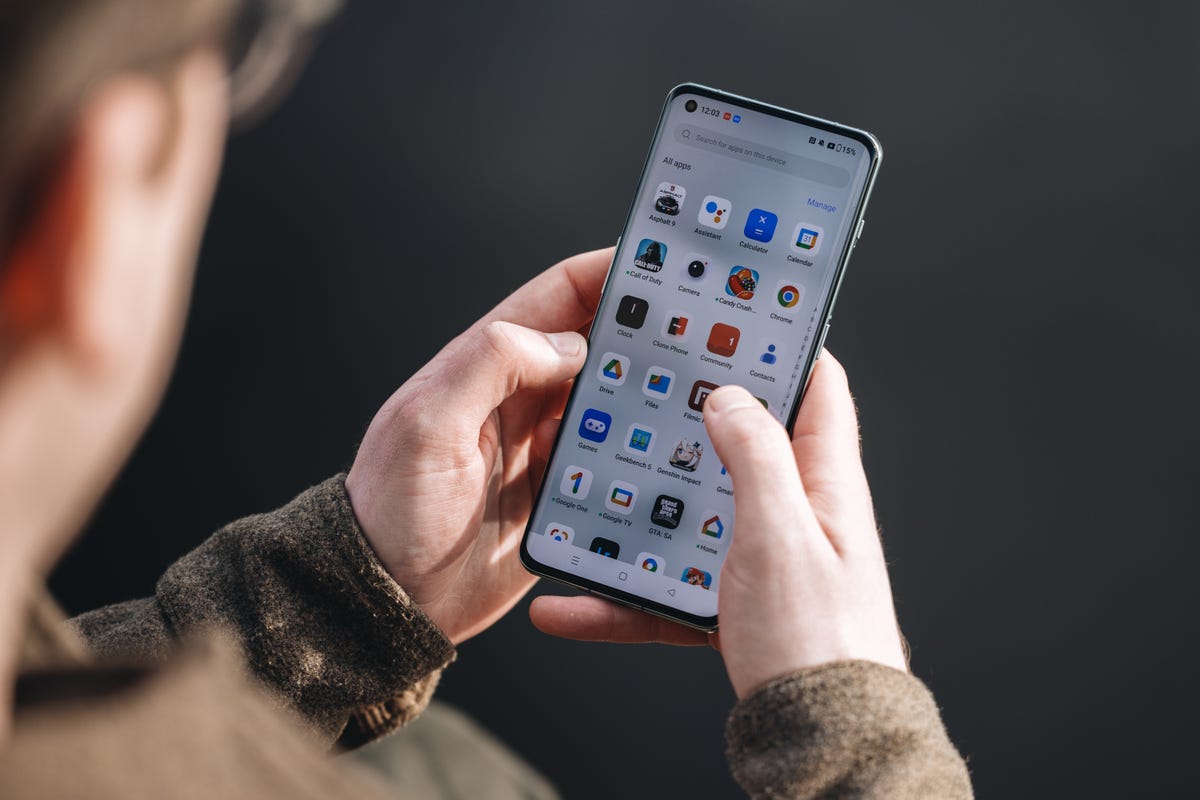

It’s a powerhouse of a phone.
Andrew Lanxon/CNETIn the real world, all that power means the phone is swift to use. Simply navigating around the Android interface is fast, smooth and free of the lag or stutters that might signal poorly configured hardware. There’s little that can slow it down. It handled video streaming and photo editing perfectly well.
That swift experience is helped by the phone’s Oxygen 13 OS software. Based on Android 13, Oxygen OS is a lightweight Android skin with a clean look that’s easy to use. I liked it straight out-of-the-box, but you can customize the system fonts and the always-on display to give it a more personal touch.
OnePlus extended its support period to four years for Android updates and an additional fifth year for security updates. That’s the longest the company has ever supported a phone for and means that the OnePlus 11 will still be safe to use five years from now.
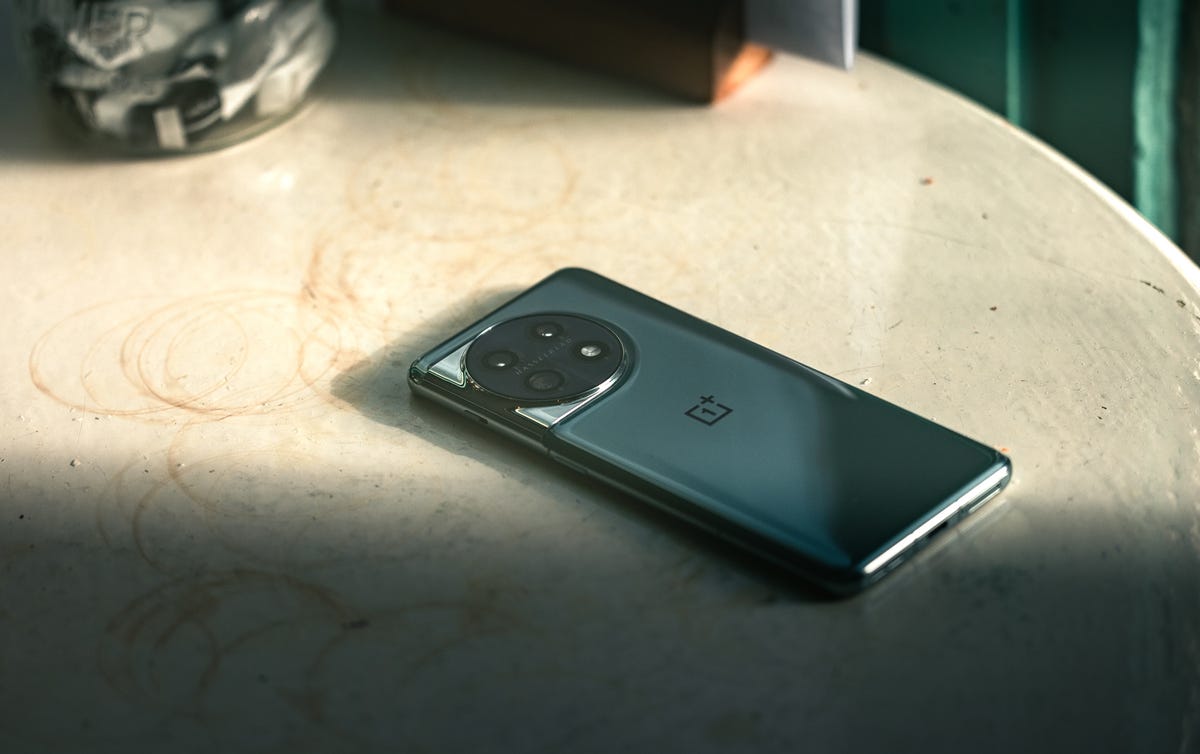

The phone looks smart and stylish.
Andrew Lanxon/CNETOnePlus 11: Cameras that could do better
There are three main cameras on the back of the OnePlus 11; a 50-megapixel main camera with an f/1.8 lens and optical image stabilization, a 48-megapixel ultra-wide camera with close focusing macro capabilities and a 32-megapixel portrait camera with a 2x optical zoom. It’s a fairly predictable triple-camera setup, but that portrait camera disappoints me.
That 2x zoom is a step down from the 3.3x zoom seen on the OnePlus 10 Pro and a big step down from the 5x telephoto zoom on the Pixel 7 Pro. Zoom skills might not seem like the most important feature, but if you want to take great images in any environment, a powerful zoom can be an invaluable tool.
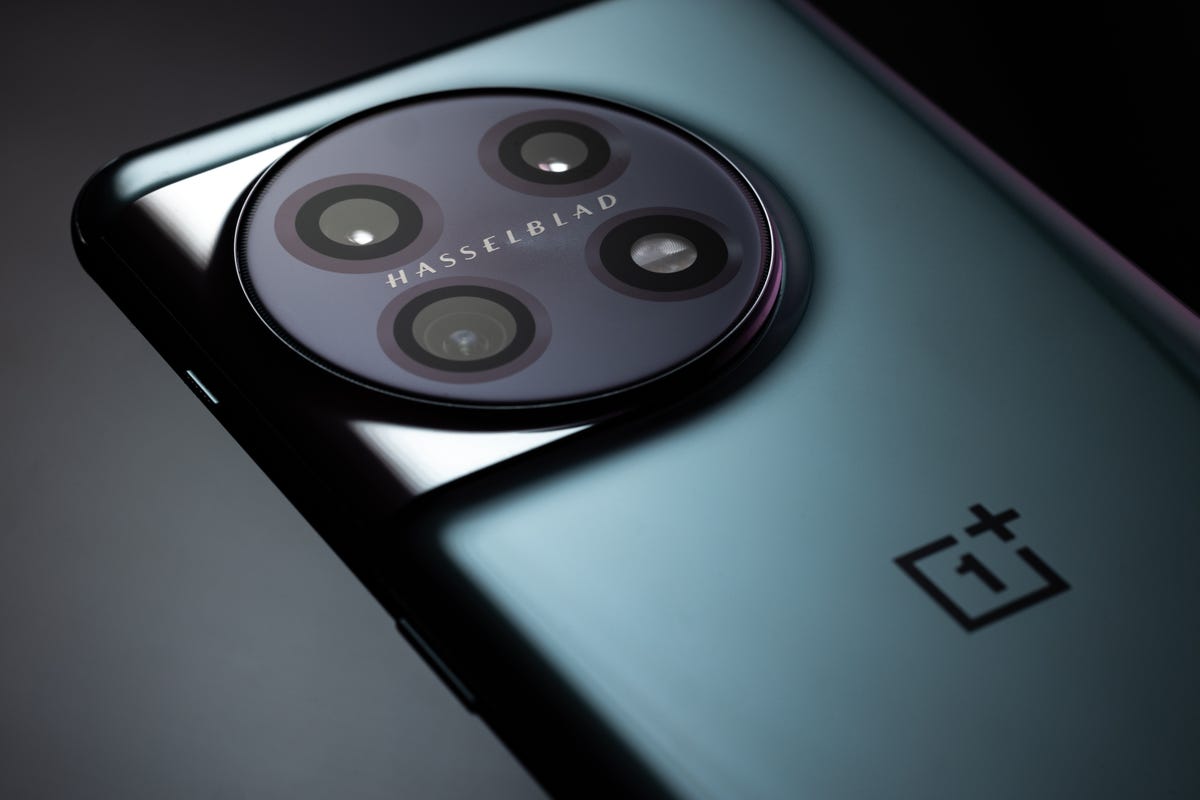

The Hasselblad name is still found on the camera unit.
Andrew Lanxon/CNETInstead of using a wide lens and simply capturing everything in front of you in one image, a long zoom lens lets you find more interesting compositions within those scenes by cropping out distracting road signs, cars or crowds of people. A telephoto lens is typically part of any professional photographer’s kit bag (including my own) and I absolutely love using the zoom on the Pixel 7 Pro — and the whopping 10x optical zoom on the Samsung Galaxy S22 Ultra. Even the 3x on the iPhone 14 Pro gives me more room to work with.
Not having a proper telephoto lens on the OnePlus 11 feels like I have to make compromises in my photography that I wouldn’t with other phones. It’s not as fully rounded of a photography package as a result.
OnePlus has again partnered with iconic camera maker Hasselblad, which has apparently calibrated the camera for better colors. However, I’m not sure it’s doing either company much good as the results are hit-and-miss. While some shots look true to life, with punchy colors and pleasing contrast, others look oversaturated, with heavy-handed HDR processing that lifts shadows and tones down highlights to an unrealistic degree.
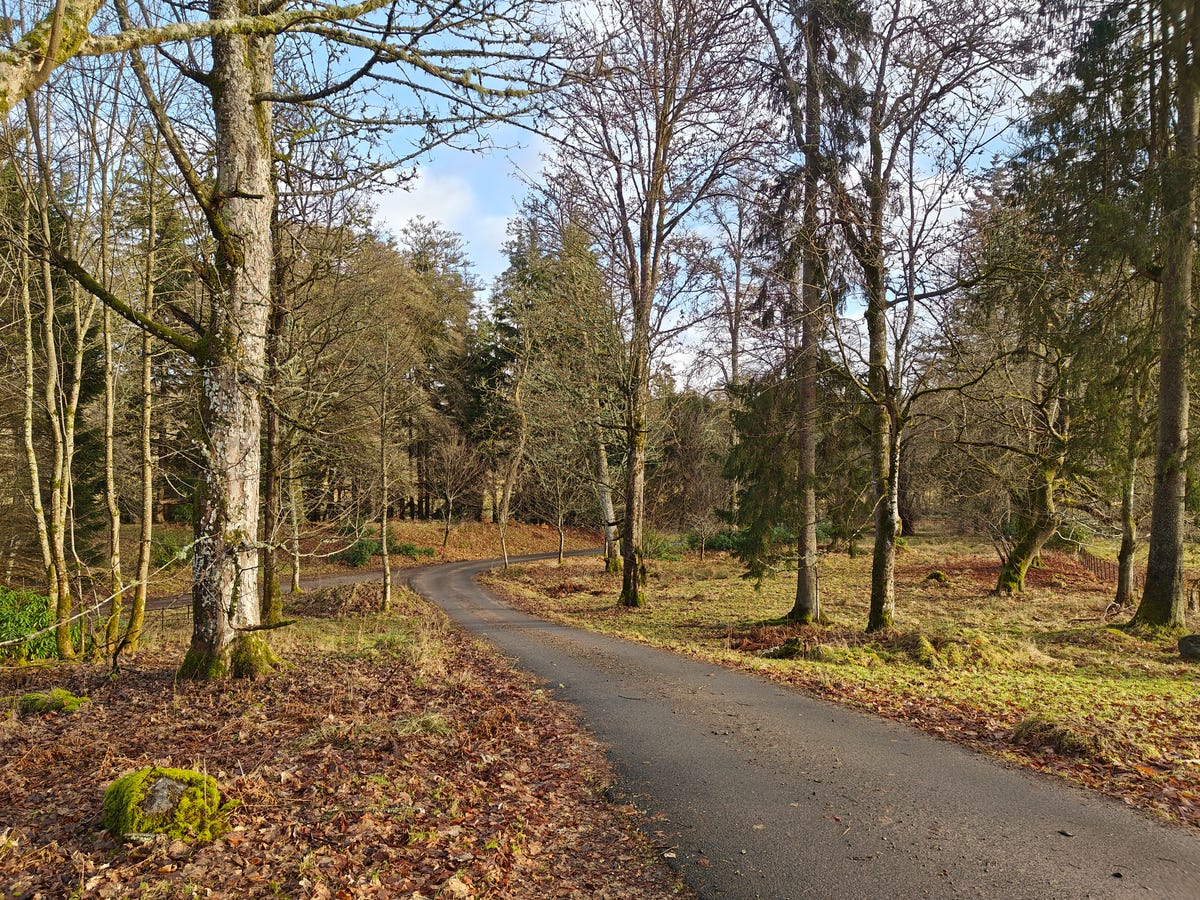

OnePlus 11, main camera
Andrew Lanxon/CNETTaken with the main camera, this image above is beautifully exposed, with warm colors and plenty of detail.


OnePlus 11, main camera
Andrew Lanxon/CNETThis shot above of a ruined cottage deep in the forest is vibrant and pin-sharp. It’s a great snap, all round.


OnePlus 11, main camera
Andrew Lanxon/CNETThe close-up shot above is absolutely packed with detail and the colors look spot-on. Nice work, OnePlus.


OnePlus 11, main camera
Andrew Lanxon/CNETVibrant blue sky, lovely detail on the building to the left and a lovely flash of color from the rainbow. The phone has captured this scene above well.


OnePlus 11, main camera
Andrew Lanxon/CNETThis scene doesn’t impress me though. The phone’s software has really gone hard on the HDR processing, lifting the shadows here to such an extent that the shot above looks unrealistic.


iPhone 14 Pro, main camera
Andrew Lanxon/CNETTaken on the iPhone 14 Pro, this comparison image above is darker, but the deeper shadows against that bright blue sky are much more realistic and this shot looks much more natural as a result.


OnePlus 11, main camera
Andrew Lanxon/CNETThe OnePlus 11’s main camera has again lifted the shadows quite a lot in the snap above. The sky has more of a teal tone to it, which doesn’t reflect reality.


Pixel 7 Pro, main camera
Andrew Lanxon/CNETThe Pixel 7 Pro’s shot above has a deeper contrast and more natural color tones both on the buildings and in the sky.


OnePlus 11, ultrawide lens
Andrew Lanxon/CNETSwitching to the ultrawide camera, the OnePlus 11’s heavy-handed auto HDR resulted in the image above where the sky looks almost fake against the buildings. There’s also a noticeable color shift between the OnePlus 11’s main camera and ultrawide — a detail I’d noticed on the OnePlus 10 Pro, too.


Pixel 7 Pro, ultrawide lens
Andrew Lanxon/CNETBy not reducing the brightness in the sky to the same extent, the Pixel 7 Pro’s shot above looks more authentic.


OnePlus 11, ultrawide lens, macro mode.
Andrew Lanxon/CNETUsing the macro mode on the ultrawide lens, the OnePlus 11 has delivered a great close-up shot above. I love the rich, vibrant green tones.


iPhone 14 Pro, ultrawide lens, macro mode.
Andrew Lanxon/CNETBy comparison, the iPhone 14 Pro’s macro mode has produced the shot above where the green tones are quite washed out and yellow-ish. I don’t like it as much.


OnePlus 11, 2x portrait mode.
Andrew Lanxon/CNETThe OnePlus 11 Pro lacks the zoom prowess of some of its competitors, but its 2x lens does allow for decent portrait shots. The colors in the image above are a little cold, and there’s not a ton of detail on my face. But the blur effect is nice.


iPhone 14 Pro, 2x portrait mode.
Andrew Lanxon/CNETThe iPhone 14 Pro’s 3x portrait mode has resulted in a closer-up portrait (it was shot from the same position), and I think there’s better background blur (known as bokeh) here. The details on my face are sharper too, and although the color tones give a warmer look to the image above. It’s a strong yellow effect that I don’t like any more than the cold look of the OnePlus 11’s shot.


OnePlus 11, 2x zoom.
Andrew Lanxon/CNETThere’s no question, though, that I’d miss having a larger zoom. Above is an image from the 2x zoom lens on the OnePlus 11.


Pixel 7 Pro, 5x optical zoom.
Andrew Lanxon/CNETThe 5x optical zoom of the Pixel 7 Pro lets you get creative zoomed-in shots, like above, that are out of reach for the OnePlus.


OnePlus 11 main camera, Hasselblad filter applied.
Andrew Lanxon/CNETAs part of the Hasselblad partnership, the phone comes with a variety of color presets created by Hasselblad ‘Master’ photographers. Take a look above. I don’t really like them and would much prefer to simply edit images my own way using any of the very good photo editing apps on the Google Play store.


OnePlus 11, night mode.
Andrew Lanxon/CNETAt night the camera performs very well however. I was impressed at the brightness it was able to achieve, delivering brighter images (see above) than even the iPhone 14 Pro, albeit with less detail.


iPhone 14 Pro, night mode.
Andrew Lanxon/CNETThe iPhone 14 Pro’s night mode shot above has a touch more detail on some of the distant buildings, but it’s not as bright as the shot from the OnePlus.


OnePlus 11, night mode.
Andrew Lanxon/CNET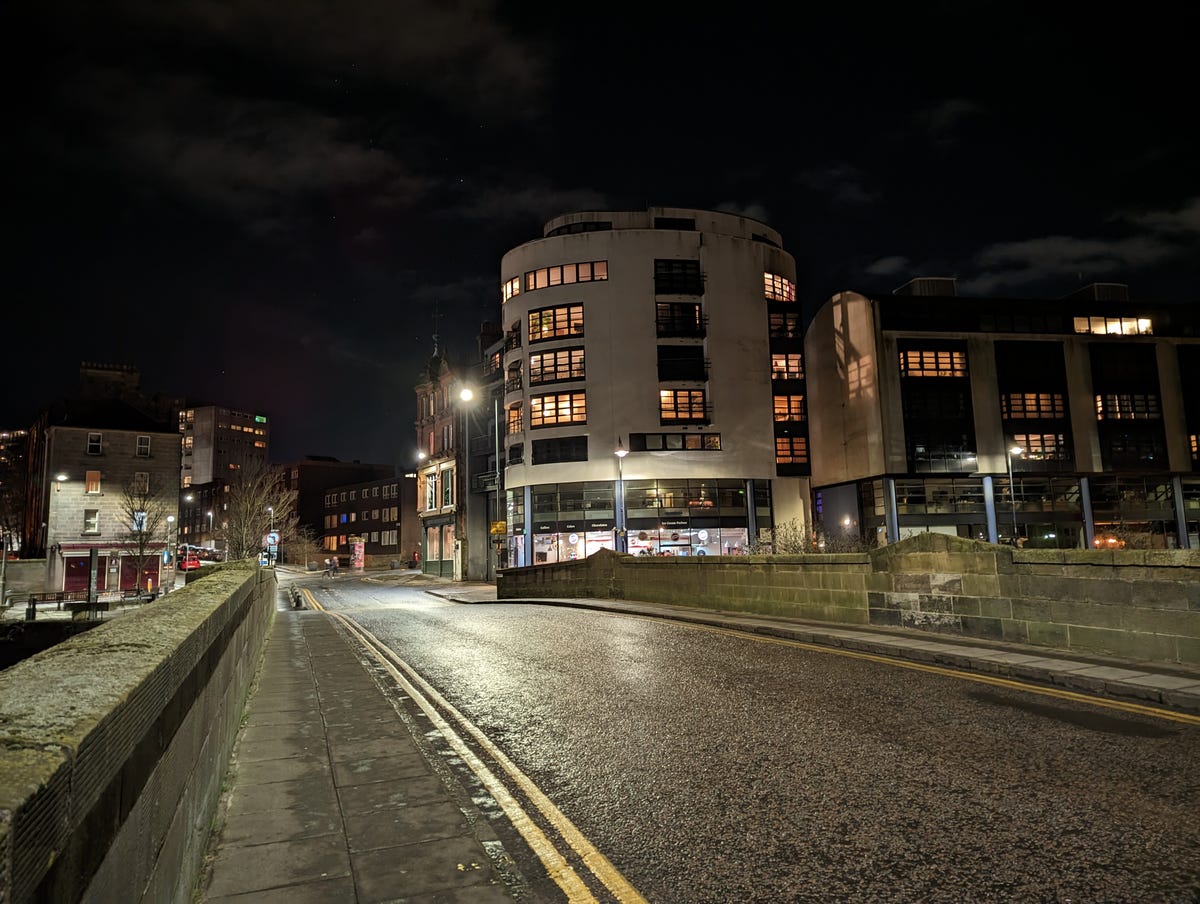

Pixel 7 Pro, night mode.
Andrew Lanxon/CNETIt’s brighter than night mode shots from the Pixel 7 Pro, too. See above.
It’ll shoot video at up to 8K resolution, but its standard 4K footage will be plenty for most, offering HDR footage that helps keep bright skies under control. Colors look good in videos and while the optical image stabilization helps smooth out shaky hands, it can result in upright objects in your footage (trees, for example) appearing wobbly as the sensor tries to correct the movement. Check out the video below for some clips recorded on the OnePlus 11.
The camera can take some great shots overall. If photography isn’t a huge focus for you, and you just want crisp, vibrant shots of your friends or your kids at the beach then you’ll be well served by the OnePlus 11 — particularly if you like taking photos at night. If you’re looking for a more well-rounded photography experience then look toward the Pixel 7 Pro.
OnePlus 11: Solid battery and fast charging
The phone runs on a 5,000mAh battery that’s capable of getting you through a full day of use, as long as you’re reasonably careful in how you use it. With the display set to its maximum 3,216×1,440-pixel resolution, at 120Hz refresh rate and with screen brightness on max, the battery dropped from full to 92% remaining after 1 hour of streaming a YouTube video. After the second hour it had dropped to only 85% remaining, which isn’t a great performance.
With the resolution dropped to 2,412×1,080 pixels and the refresh rate at a maximum of 60Hz, it didn’t even drop below 100% after an hour of YouTube streaming and only dropped to 95% after a second hour — not bad at all. But 30 minutes of gaming in Genshin Impact with all settings on max comfortably knocked 10% off the battery.
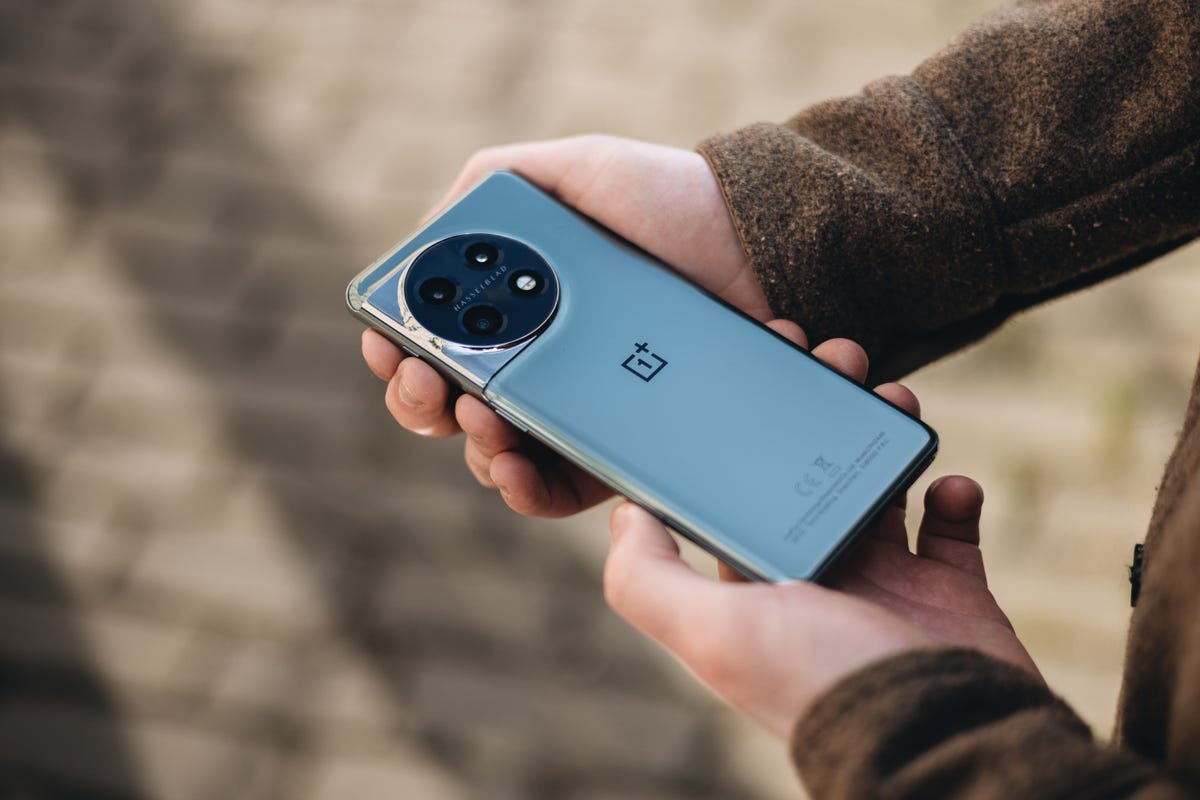

The phone’s battery can provide a day of use.
Andrew Lanxon/CNETWith more conservative settings you won’t need to worry too much about your phone dropping dead halfway through the afternoon, and you should still have plenty of juice remaining when you put it on charge at night. Demanding gamers can ramp up the settings when you want to enjoy every last detail, but make sure you’ve got your charger nearby.
Thankfully, even if you do drain the battery with gaming or YouTube streaming, getting the juice back in is a speedy process. The phone supports 100-watt fast charging in the UK (80W in the US) which will fill the battery from empty in only 25 minutes — or 27 minutes on the 80W model. That’s quicker than the 1 to 2 hours you can expect a full recharge of the Pixel 7 Pro to take.


The OnePlus 11 is a solid all-round phone.
Andrew Lanxon/CNETOnePlus 11: Should you buy it?
If you’re looking for a high-performance phone to tackle gaming, video streaming and all of life’s essentials, the OnePlus 11 is an excellent phone to consider. It’s got power enough to tackle anything in the Google Play store, it looks great and its fast-charging means that battery life isn’t an issue. The five years of security support is a nice bonus, too.
And while the camera setup is far from the best around, it’s perfectly capable of taking shots of your kids on holiday you’ll be excited to share with your wider family and friends.
But it’s the price that stands out here, being one of the cheapest flagships you can buy, undercutting both the Pixel 7 Pro and Samsung Galaxy S23. If photography isn’t your top priority but you do want ultimate performance for gaming on the go, the OnePlus 11 is certainly worth your time.
How we test phones
Every phone tested by CNET’s reviews team is actually used in the real world. We test a phone’s features, play games and take photos. We examine the display to see if it’s bright, sharp and vibrant. We analyze the design and build to see how it is to hold and whether it has an IP-rating for water resistance. We push the processor’s performance to the extremes using both standardized benchmark tools like GeekBench and 3DMark, along with our own anecdotal observations navigating the interface, recording high-resolution videos and playing graphically intense games at high refresh rates.
OnePlus 11 specs vs. Google Pixel 7 Pro, Samsung Galaxy S23 Ultra, Apple iPhone 14 Pro Max
| OnePlus 11 | Google Pixel 7 Pro | Galaxy S23 Ultra | iPhone 14 Pro Max | |
| Display size, tech, resolution, refresh rate, brightness | 6.7-inch AMOLED; 3,216 x 1,440 pixels; 120Hz Adaptive Refresh Rate | 6.7-inch OLED LTPO display; QHD+ 1,440 x 3,120 pixels; 120Hz Adaptive Refresh Rate | 6.8-inch AMOLED; 3,088×1,440 pixels; 120Hz Adaptive Refresh Rate | 6.7-inch Super Retina XDR OLED display; 2,796×1,290 pixels; 120Hz Adaptive Refresh Rate |
| Pixel density | 525 ppi | 512ppi | 500 ppi | 460 ppi |
| Dimensions (inches) | 2.92 x 6.42 x 0.33 in | 6.14 x 3.02 x 0.35 in | 6.43 x 3.07 x 0.35 in | 6.33 x 3.05 x 0.31 in. |
| Dimensions (millimeters) | 74.1 x 163.1 x 8.5 mm | 162.9 x 76.6 x 8.9 mm | 163.3 x 78 x 8.9 mm | 160.7 x 77.6 x 7.85mm |
| Weight (ounces, grams) | 205 g (7.23 oz) | 212 g (7.5 oz) | 234 g (8.25 oz) | 240 g (8.47 oz) |
| Mobile software | Android 13 | Android 13 | Android 13 | iOS 16 |
| Camera | 50-megapixel (wide), 48-megapixel (ultrawide), 32-megapixel (telephoto) | 50-megapixel (main), 12-megapixel (ultrawide), 48-megapixel (telephoto) | 200-megapixel (main), 12-megapixel (ultrawide) 10-megapixel (telephoto) 10-megapixel (telephoto) | 48-megapixel (wide), 12-megapixel(ultrawide), 12-megapixel(telephoto) |
| Front-facing camera | 16-megapixel | 10.8- megapixel | 12-megapixel | 12-megapixel |
| Video capture | 8K | 4K | 8K | 4K |
| Processor | Qualcomm Snapdragon 8 Gen 2 | Google Tensor G2 | Galaxy-optimized Qualcomm Snapdragon 8 Gen 2 | Apple A16 Bionic |
| RAM/storage | 8GB RAM + 128GB; 12GB RAM + 256GB | 12GB + 128 GB, 12GB + 256GB, 12GB + 512GB | 12GB + 256GB; 12GB + 512GB; 12GB + 1TB | RAM NA; 128GB, 256GB, 512GB, 1TB |
| Expandable storage | None | None | None | None |
| Battery/charging speeds | 5,000 mAh (80W wired charging in US, 100W in UK) | 5,000 mAh (20W wired charging) | 5,000 mAH (45W wired charging) | Undisclosed; Apple claims 29 hours of video playback |
| Fingerprint sensor | In-display | In-display | In-display | None (Face ID) |
| Connector | USB-C | USB-C | USB-C | Lightning |
| Headphone jack | None | None | None | None |
| Special features | 5G, IP64 rating, dual-batteries, 80W power adapter included in box | 5G, IP68 rating, Face Unblur | 5G (mmw/Sub6), IP68 rating, faster wired charging, wireless PowerShare to charge other devices, integrated S-Pen, 200x Space Zoom, 10x Optical Zoom, UWB for finding other devices | Dynamic Island; Always-On display; 5G enabled; MagSafe; water resistant (IP68); wireless charging; dual-SIM capabilities (e-SIM) |
| US price off-contract | $799 (8GB/128GB) | $899 (12GB/128GB) | $1,200 (12GB/256GB) | $1,099 (128GB), $1,199 (256GB), $1,399 (512GB), $1,599 (1TB) |
| UK price | 729 (8GB/128GB) | 849 (12GB/128GB) | 1,249 (12GB/256GB) | 1,199 (128GB) |
| Australia price | Converts to AU$1,270 (8GB/128GB) | AU$1,299 (12GB/128GB) | AU$1,949 (12GB/256GB) | AU$1,899 (128GB) |
All the cameras are tested in a variety of conditions from bright sunlight to dark indoor scenes. We try out special features like night mode and portrait mode and compare our findings against similarly priced competing phones. We also check out the battery life by using it daily as well as running a series of battery drain tests.

